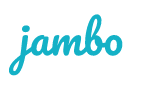
Did you know your stakeholder data can be used for more than helping to meet your regulatory requirements or gaining buy-in? Consistently inputting your data into a Stakeholder Relationship Management (SRM) software means you’ll collect a lot of stakeholder engagement information that has a multitude of uses, so make the most of your efforts and don’t let it go to waste. You can use it to illustrate your project’s progress, its impact on your team(s) and communities, the breadth and depth of your engagements, and so much more!
Below, we’ve put together some expert tips and examples showing you how to get the most out of your stakeholder data!
1. Roll up your stakeholder data
Throughout your engagement journey, you’ll collect a LOT of stakeholder information and engagement data that you can roll up to use and share with your stakeholders and shareholders. Whether you’re drafting an annual report, investor relations report, corporate social responsibility report, or anything in between, the data stored in your SMR can be used in project updates, to answer questions, and as a way to back up your efforts.
By utilizing reports that you can quickly run directly from your SRM, you can roll up your data across your project(s) to answer questions like:
- How many people have you talked to?
- How many engagement sessions have you held?
- How many issues have you addressed (or have you yet to address)?
- How many commitments have you made?
These reports help you talk about your data at a higher level and show specific examples to prove how you’ve been following through on important tasks and everything you’ve accomplished in your project.
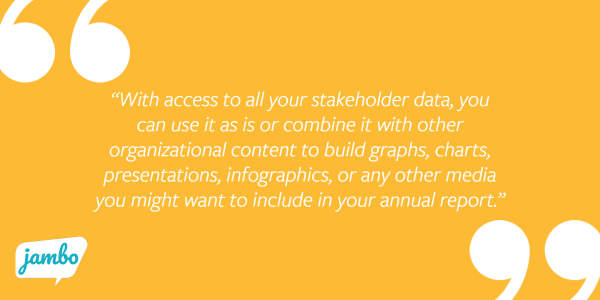
A real-life example from our experts: It’s important to show progress towards your strategic objectives and goals in your annual report but putting all this information together across multiple projects can be time-consuming. With an SRM, you can easily pull the stakeholder data you need to show your team(s) progress. With an SRM like Jambo, it’s easy to get your data into and out of the platform, so whether you want to use one of the included reports or export all your data into a CSV file, it’s possible. With access to all your stakeholder data, you can use it as is or combine it with other organizational content to build graphs, charts, presentations, infographics, or any other media you might want to include in your annual report.
2. Track goals and KPIs
You have goals, objectives, and KPIs (Key Performance Indicators) that your team, project, or organization is trying to achieve, and your stakeholder data can help you track your progress towards these. You can track your goals in your SRM by running reports, doing quick searches, or building direct associations within the platform.
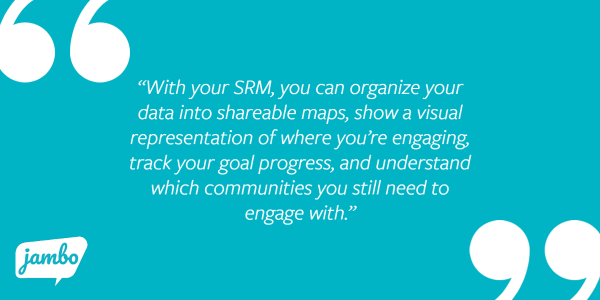
A real-life example from our experts: A common project-level goal for organizations is to engage with the breadth and diversity of the communities in which they’re engaging. You may say, “We want to communicate with groups from every quadrant and community within the region we’re doing development in. Therefore, we need to make sure we’re engaging people from all of these areas.” With your SRM, you can organize your data into shareable maps, show a visual representation of where you’re engaging, track your goal progress, and understand which communities you still need to engage with.
3. Illustrate the impact your project has had with a community
It’s powerful to be able to show your project's impact within the community you’re engaging, and your stakeholder data can help you do this.
Some examples of the impact you could illustrate with your stakeholder data:
- The number of community members involved. Your stakeholders might not know you’ve spoken with their neighbours already, it can be impactful to quantify the participation from the community and share summaries of the feedback you’re hearing, so stakeholders are aware of the other perspectives in their community. It’s also a good opportunity to ask for participation from people who have different perspectives.
- You’re following through on your commitments. If you’ve made a lot of commitments and followed through on many of them, reporting on those completed commitments can help you build social capital within the community as it shows you’re accountable.
- The donations or monetary contributions you’ve made. You can talk about the donation(s) you’ve made and the feedback you’ve received on why the donation is important. (e.g. the community has been struggling to meet their development goal to build a sports facility, and you've donated to ensure it gets completed.)
- You’re addressing issues. Are you addressing a lot of common stakeholder issues within the community? By using your stakeholder data to identify what you’ve done and who you’ve talked to, you can share your dedication to solving problems within the community.
Whether you’ve solved a challenge, contributed financially, or given community members the opportunity to bring forward their perspectives, you can share what you’ve done and what you’ve learned from your stakeholder participation to help show the positive impacts your project is having within the community.
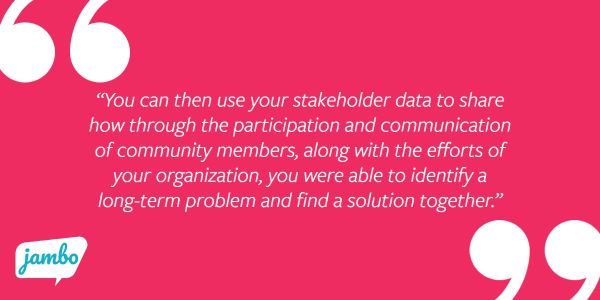
A real-life example from our experts: As you talk with community members, you may learn of something that has been a challenge for them (e.g. the kind of snow clearing being used on a particular road makes it hard to travel.) As part of your project, you may decide to solve this challenge. You can then use your stakeholder data to share how through the participation and communication of community members, along with the efforts of your organization, you were able to identify a long-term problem and find a solution together.
4. Show how your stakeholder participation and feedback has been incorporated
Following up with your stakeholders is key to building trust and if not done correctly, can make or break your engagement programs. If you're having great conversations, but your stakeholders never hear from you again, that's not productive in building positive stakeholder relationships. Be sure to follow up with your stakeholders to let them know where their feedback was used and where it wasn't used in the project (if possible).
With your stakeholder data stored in your SRM, you can easily pull insights from some of your communication records and reports with your stakeholders to say, "This is what we've heard, and this is what we've captured. Did we miss anything? Is this all still true? Do you want to add anything?”
Demonstrating that people have been heard goes a long way in building their trust in the engagement process. Remember, people will support what they help build and if you can relay the areas where their voice and input was included, that can go a long way. Those specific examples available right within your stakeholder data are important!
5. Track issues and follow up to show they’ve been addressed
An SRM with a tags feature will help you organize and use your stakeholder data even more efficiently. You can add tags to your data to track important trends, themes, or issues to stay on top of what’s happening and communicate updates to your stakeholders.
When it comes to issues, if you’re engaging with communities across a large region and you hear a lot of similar concerns, you can use your tags and reports to track and identify issues and share back with communities your findings to say something like, “You’re not alone in this. It looks like these are big issues for everyone in the region, so we’ll make them a priority.”
Tracking your stakeholder issues helps ensure you don't forget about what they’ve shared and allows you to follow up and say, “Thank you for bringing this forward. Now we understand how important this is not just for us but for you and other communities. We can work on this because you took the time to share your concerns and priorities. We have a better understanding of the community’s needs because of you and will incorporate that into our plan.”
Bringing up the issues stakeholders have shared with you and letting them know what’s happening with them shows that they’re part of a larger conversation and their input is valued and taken into consideration.
Looking for some advice on how to manage stakeholder issues? Watch our webinar with BRITT RADIUS.
A real-life example from our experts: Your stakeholders have lived experience and unique knowledge that can enhance your project. Their feedback is valuable, and it's important to let them know what you're doing with the information they have shared with you. If you're building a public facility, and you receive lots of feedback asking for, say, accessible reception desks, you may choose to include that feedback in your project to meet that request. Now you can come back to your stakeholders and say, "We heard your request for accessible reception desks. Thank you for this feedback. It's important, and we've made sure they have been added to the build." By taking the stakeholder feedback and relaying it back to them so they hear their voice in your reports and records, you’re showing them their input matters and has made a positive impact.
6. Show your team’s internal impact within your organization
A lot of stakeholder engagement teams’ work is external, so it's not always recognized internally. But there's a lot of power in using your stakeholder data to highlight your team's external impact within your organization.
With the stakeholder data already stored in your SRM, you can easily share internal updates on:
- The number of commitments your team has fulfilled
- The number of communities your team has communicated with across the region
- The total number of communications that have taken place within a certain timeframe
- The number of new stakeholder relationships built
By sharing this kind of data, you can show the organizational impact your team’s work has had or is having. Whether it's through the social capital gained from the positive stakeholder relationships being built, the improvement to your organization’s reputation gained from community initiatives, or even how you’re helping others within your organization do their jobs more effectively. Using the stakeholder data stored in your SRM and the ability to run useful reports, you can illustrate these impacts and use them to celebrate your team's efforts and to talk about the positive outcomes you're seeing.
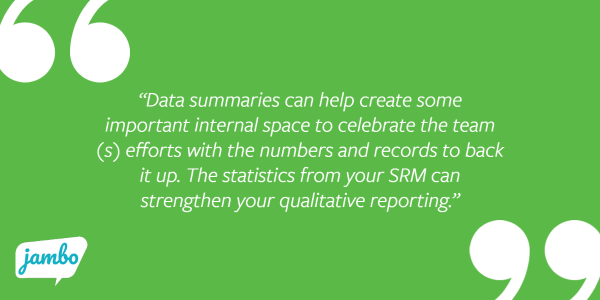
A real-life example from our experts: With your departmental reporting, you may have quarterly meetings, internal board meetings, or internal executive team meetings, and these can be great opportunities to bring your SRM reports that show how much work has been accomplished. These data summaries can help create some important internal space to celebrate the team(s) efforts with the numbers and records to back it up. The statistics from your SRM can strengthen your qualitative reporting.
Next steps: Improve your stakeholder data management
To make sure you can get the most out of your stakeholder data, read our blog on 3 Tips for Better Stakeholder Data Management.




